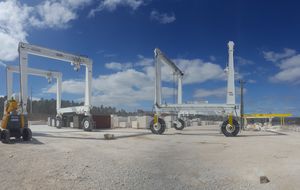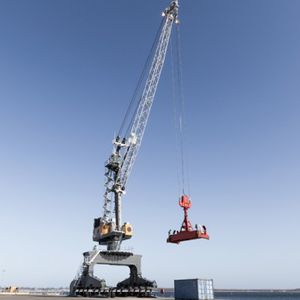- Harbors and port terminals >
- Cargo handling >
- Rubber-tired crane
Rubber-tired cranes
{{product.productLabel}} {{product.model}}
{{#if product.featureValues}}{{product.productPrice.formattedPrice}} {{#if product.productPrice.priceType === "PRICE_RANGE" }} - {{product.productPrice.formattedPriceMax}} {{/if}}
{{#each product.specData:i}}
{{name}}: {{value}}
{{#i!=(product.specData.length-1)}}
{{/end}}
{{/each}}
{{{product.idpText}}}
{{product.productLabel}} {{product.model}}
{{#if product.featureValues}}{{product.productPrice.formattedPrice}} {{#if product.productPrice.priceType === "PRICE_RANGE" }} - {{product.productPrice.formattedPriceMax}} {{/if}}
{{#each product.specData:i}}
{{name}}: {{value}}
{{#i!=(product.specData.length-1)}}
{{/end}}
{{/each}}
{{{product.idpText}}}

Lifting capacity: 10 t - 235 t
GH industrial automotive gantry cranes are available from 10ton to 400 ton as standard. With the features and benefits provided by this type of machine, it can be adapted to different industries that require lifting and ...

Lifting capacity: 42, 64, 84, 124, 144 t
... LPM-series combines a space-saving crane installation mounted on a portal with utmost mobility given through conventional rubber tyres. In fact, the design is a mix of the well-established Liebherr mobile ...
Liebherr-International Deutschland

Lifting capacity: 19,200 kg - 160,000 kg
Efficient Liebherr handlers are designed to promote faster cycles and greater handling capacities. Setting new standards in terms of energy and fuel consumption. LH 40 M Port Litronic The new LH 40 Port material handling machine was ...
Liebherr-International Deutschland

... rotation chassis walking boom crane. Tire cranes lifting mechanism is mounted on the special chassis heavier type tires and axle consisting of an all-slewing crane, its upper structure ...
Your suggestions for improvement:

A rubber-tired crane can lift and move loads from place to place. It is mounted on a self-propelled vehicle with a steering system.
ApplicationsSuch cranes are used for moving bulk cargo, harbor construction and shipyard work and for other port operations.
TechnologiesThe crane base holds a rotating platform and the vehicle's propulsion system. The operator's cabin has both crane and vehicular controls. It can be situated on the base or elevated above it. The boom is mounted on the platform and uses cables, slings and hooks to handle loads. There are usually hydraulic legs attached to the base for stability during lifting operations.
How to chooseChoice will depend primarily on lift capacity, the size and weight of the loads to be handled and the nature of the terrain where the crane will operate.
- Mobility
- Adaptability
- Tipping risk
the best suppliers
Subscribe to our newsletter
Receive regular updates on this section.
Please refer to our Privacy Policy for details on how NauticExpo processes your personal data.
- Brand list
- Manufacturer account
- Buyer account
- Our services
- Newsletter subscription
- About VirtualExpo Group





Please specify:
Help us improve:
remaining